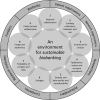Recommendations for a Dutch Sustainable Biobanking Environment
- PMID: 34042498
- PMCID: PMC8217590
- DOI: 10.1089/bio.2021.0011
Recommendations for a Dutch Sustainable Biobanking Environment
Abstract
Biobanks and their collections are considered essential for contemporary biomedical research and a critical resource toward personalized medicine. However, they need to operate in a sustainable manner to prevent research waste and maximize impact. Sustainability is the capacity of a biobank to remain operative, effective, and competitive over its expected lifetime. This remains a challenge given a biobank's position at the interplay of ethical, societal, scientific, and commercial values and the difficulties in finding continuous funding. In the end, biobanks are responsible for their own sustainability. Still, biobanks also depend on their surrounding environment, which contains overarching legislative, policy, financial, and other factors that can either impede or promote sustainability. The Biobanking and Biomolecular Research Infrastructure for The Netherlands (BBMRI.nl) has worked on improving the national environment for sustainable biobanking. In this article, we present the final outcomes of this BBMRI.nl project. First, we summarize the current overarching challenges of the Dutch biobanking landscape. These challenges were gathered during workshops and focus groups with Dutch biobanks and their users, for which the full results are described in separate reports. The main overarching challenges relate to sample and data quality, funding, use and reuse, findability and accessibility, and the general image of biobanks. Second, we propose a package of recommendations-across nine themes-toward creating overarching conditions that stimulate and enable sustainable biobanking. These recommendations serve as a guideline for the Dutch biobanking community and their stakeholders to jointly work toward practical implementation and a better biobanking environment. There are undoubtedly parallels between the Dutch situation and the challenges found in other countries. We hope that sharing our project's approach, outcomes, and recommendations will support other countries in their efforts toward sustainable biobanking.
Keywords: biobank; macro-environment; overarching challenges; policy recommendations; sustainability.
Conflict of interest statement
The authors report potential political conflicts of interest. P.M. is director of the Radboud Biobank, the centralized biobank infrastructure of the Radboudumc Nijmegen and R.v.d.S. is project manager of the UMCG Cohort and Biobank Coordination Hub. Several of the recommendations are positive toward such infrastructures. In addition, P.M. will function as one of the two coordinators of the new Health-RI Biobank Community, which is the effectuation of one of the recommendations. She was not yet a community coordinator when the recommendations were drafted. More likely, her involvement in this
Figures

Similar articles
-
[Dutch government invests in existing biobanks].Ned Tijdschr Geneeskd. 2010;154:A2825. Ned Tijdschr Geneeskd. 2010. PMID: 21029488 Dutch.
-
Critical Financial Challenges for Biobanking: Report of a National Cancer Institute Study.Biopreserv Biobank. 2019 Apr;17(2):129-138. doi: 10.1089/bio.2018.0069. Epub 2019 Jan 14. Biopreserv Biobank. 2019. PMID: 30638412 Free PMC article.
-
The landscape of biobanks in Poland-characteristics of Polish biobanking units at the beginning of BBMRI.pl organization.J Transl Med. 2021 Jun 22;19(1):267. doi: 10.1186/s12967-021-02926-y. J Transl Med. 2021. PMID: 34158056 Free PMC article.
-
Biobanking in health care: evolution and future directions.J Transl Med. 2019 May 22;17(1):172. doi: 10.1186/s12967-019-1922-3. J Transl Med. 2019. PMID: 31118074 Free PMC article. Review.
-
The Future of Biobanking: A Conceptual Look at How Biobanks Can Respond to the Growing Human Biospecimen Needs of Researchers.Adv Exp Med Biol. 2015;864:11-27. doi: 10.1007/978-3-319-20579-3_2. Adv Exp Med Biol. 2015. PMID: 26420610 Review.
Cited by
-
Sustainable biobanks: a case study for a green global bioethics.Glob Bioeth. 2022 Feb 24;33(1):50-64. doi: 10.1080/11287462.2021.1997428. eCollection 2022. Glob Bioeth. 2022. PMID: 35221664 Free PMC article.
-
Drivers and constraints to environmental sustainability in UK-based biobanking: balancing resource efficiency and future value.BMC Med Ethics. 2023 Jun 1;24(1):36. doi: 10.1186/s12910-023-00908-x. BMC Med Ethics. 2023. PMID: 37264320 Free PMC article.
-
Supporting Stewardship: Funding, Utilization, and Sustainability as Ethical Concerns in Networked Biobanking.AJOB Empir Bioeth. 2025 Jan-Mar;16(1):42-51. doi: 10.1080/23294515.2024.2399533. Epub 2024 Sep 9. AJOB Empir Bioeth. 2025. PMID: 39250773
-
Roadmap for low-carbon ultra-low temperature storage in biobanking.J Transl Med. 2024 Aug 8;22(1):747. doi: 10.1186/s12967-024-05383-5. J Transl Med. 2024. PMID: 39118108 Free PMC article. Review.
-
Pediatric biobanks to enhance clinical and translational research for children.Eur J Pediatr. 2023 Apr;182(4):1459-1468. doi: 10.1007/s00431-023-04818-3. Epub 2023 Jan 24. Eur J Pediatr. 2023. PMID: 36692622 Free PMC article. Review.
References
-
- Gee S, Georghiou L, Oliver R, et al. Financing UK biobanks: Rationale for a National Biobanking Research Infrastructure, 2013, Strategic Tissue Repository Alliances Through Unified Methods (STRATUM). https://www.escholar.manchester.ac.uk/api/datastream?publicationPid=uk-a... (accessed December22, 2020)
-
- Watson PH. Biobank classification: Communicating biorepository diversity. Biopreserv Biobank 2014;12:163–164 - PubMed
-
- Hewitt R, Watson P. Defining biobank. Biopreserv Biobank 2013;11:309–315 - PubMed
MeSH terms
LinkOut - more resources
Full Text Sources
Other Literature Sources
